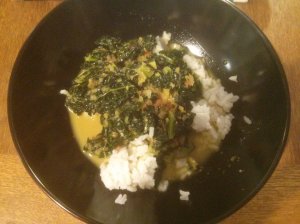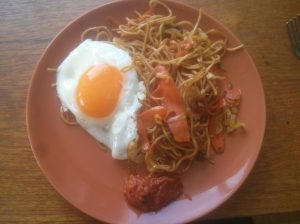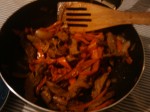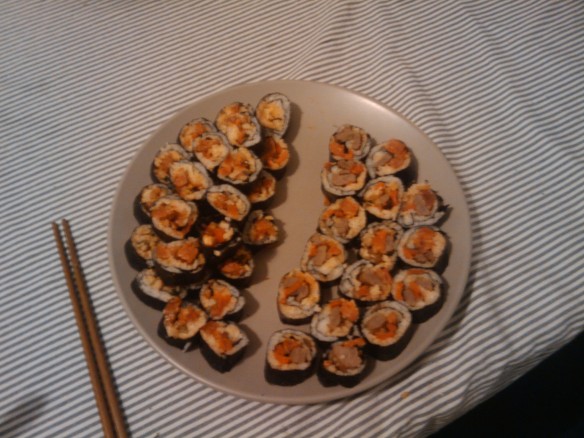In late February and early March I attended the GNOME Recipes hackfest in Yogyakarta, Indonesia. It was my second time visiting Indonesia, and food was a bit of a theme. The hackfest was about GNOME Recipes, so food, but also I love Indonesian food and I was eager to taste some more so I can improve how I cook it at home.
I haven’t contributed to GNOME Recipes. (Shamefully, not even a recipe yet!) So why was I going to a GNOME Recipes hackfest? It’s because on Endless OS we have a Cooking app, which in many ways is not as good as GNOME Recipes. It’s certainly less lovingly curated, and less community-oriented, than GNOME Recipes, and it allows recipe submissions by users while the Endless app is read-only.
However, there are a few things Endless’s Cooking app does better than GNOME Recipes: it is visually more appealing, it’s available in several languages (Arabic, Bengali, English, Portuguese, Spanish, and also a Spanish version customized for Guatemala), and it uses a better database backend (which also makes it fully offline.) It does these things using Endless’s “modular framework,” which if you want to know more about, I gave a talk two years ago at GUADEC. This modular framework is the product that I primarily work on at Endless, so a few of my team joined in the GNOME Recipes hackfest to see whether the two apps could share some technology.
It turns out that Matthias was eager to have somebody come along and make a database backend for GNOME Recipes, so the answer was yes, we could very well share some technology.
As an experiment, we made a recipes “lookalike” app using the modular framework technologies of which you can see some nice screenshots in Martin’s blog post.
We worked out some goals that we wanted to achieve by GUADEC in order to present our work, which you can see in the hackfest notes.
Outreach
There were also some goings on besides the hackfest. On the day before the hackfest started we did an outreach event for the students of AMIKOM University Yogyakarta, where the hackfest was held. We gave some talks on our work, and GNOME contributor and Endless Ambassador Siska closed the morning out with a very successful talk on how to get involved in GNOME.
After that I gave a live demo of how to make a GNOME app, the result of which you can find on GitHub here!

This is me doing the live-coding demo of a GNOME app. Some of the students said I looked like Tony Stark.
Translation
One of the most interesting discussions we had was about how to internationalize GNOME Recipes. In different countries people cook very differently, so translating a recipe from one language into another is not enough. You also have to adapt the recipe to the ingredients that you can get in the country, and sometimes it’s not possible to get the same taste. For example, if I wanted to adapt my beloved pesto recipe from Marcella Hazan’s Classic Italian Cookbook, to Indonesia, first of all I’d probably have to substitute Thai basil which would change the taste entirely. Or to adapt Indonesian recipes to Canada, you have to go to some lengths to find ingredients like terasi (shrimp paste) and kemiri (candlenuts), and we just can’t get some of the same vegetables.
It can also be that when one language is used in two countries, the same recipe still won’t work for both. For example, in the UK, baking measurements are given by weight, and in Canada and the US they are given by volume. The metric system (ºC, kg, ml) is used in the UK and the imperial system (ºF, pounds, quarts, ounces, bushels, specks, caltrops, and jeroboams) in the US. To make matters worse, Canada uses the metric system for weight and volume measurements (kg, ml) but oven temperatures are given in Fahrenheit as in the US. All three countries cook with teaspoons and tablespoons, but teaspoons and tablespoons are metric in Canada and the UK (5 ml and 15 ml) but imperial in the US (4.93 ml and 14.79 ml).
We also discussed that many translation tools assume that the source language is always English since that’s the lingua franca of programmers, but it’s definitely not the lingua franca of cooking!
I would go so far as to say that all the existing translation infrastructure that we have for internationalizing GNOME is not going to be good enough to translate the recipes in GNOME Recipes.
Progress since then
In the time since the hackfest, I was able to make a little bit of progress on our goals. I worked on splitting out the code that handles data modelling into DModel, a separate library, so that GNOME Recipes could use it.
Food
I did get a chance to learn the flavors of Indonesian food more. When I lived in the Netherlands I already became familiar with some Indonesian food, but the Indonesian food in Indonesia is really much more delicious. In Vancouver we have only one Indonesian restaurant, which is kind of far away. And I found only one Indonesian store where I can buy ingredients like shrimp paste and candlenuts, which is even farther away.
Siska brought in packets of rendang spice paste for everyone to take home, for which I was especially grateful. Here’s a picture of my rendang that I made when I got back to Vancouver:

Rendang and rice
I also tried to make the spice paste myself (because soon I will be out of the spice paste packets) but I haven’t got it figured out yet.
Some of the other dishes that I’ve made at home:

Gulai curry (substituting kale for the cassava greens)
(The recipe is from Daily Cooking Quest which is a cooking blog from an Indonesian blogger who emigrated to the United States, and I’ve had good luck with those recipes because she uses ingredients that are possible for me to get in Vancouver, and she also gives the Indonesian names of the ingredients)

Mi goreng
I am going to try making gudeg this week, which is a jackfruit curry, a specialty of Yogyakarta.
Acknowledgements
 I’d like to thank AMIKOM University Yogyakarta for hosting the hackfest and giving us the opportunity to get some students interested in open source development, and the GNOME Foundation for sponsoring my travel and accommodations during the hackfest. Thanks also to Cosimo, Ekta, Elvin, Emmanuele, Haris, Jonathan, Kukuh, Martin, Matthias, Rama, Siska, and Umang, and also Kiki from Mozilla who joined on the last day, and Angky from Endless who helped arrange the hosting and logistics, for making the event a success!
I’d like to thank AMIKOM University Yogyakarta for hosting the hackfest and giving us the opportunity to get some students interested in open source development, and the GNOME Foundation for sponsoring my travel and accommodations during the hackfest. Thanks also to Cosimo, Ekta, Elvin, Emmanuele, Haris, Jonathan, Kukuh, Martin, Matthias, Rama, Siska, and Umang, and also Kiki from Mozilla who joined on the last day, and Angky from Endless who helped arrange the hosting and logistics, for making the event a success!










